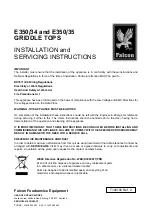
en
24 / 64
4.4
Removing the collecting container
CAUTION! Hot surfaces, hot liquids!
Risk of burning! Risk of scalding if the collecting container is filled with hot liquid! Risk
of burning if touching or hot liquids spill over!
.
Wear waterproof protective gloves!
.
Exercise appropriate caution!
5.
Completion of operation
.
Turn rotary switch to the 0 position.
● The indicator lights go out.
.
Clean the appliance - see the following 6. "Cleaning and Care" chapter.
.
Switch off the electric main switch upstream of the appliance, or disconnect the mains plug.
6.
Cleaning and Care
CAUTION!
● Do not apply any caustic cleaners to the control panel or rotary switches!
● Do not spray or clean the appliance with water hoses, high pressure cleaners, high pressure
steam cleaners or steam cleaners!
● Follow the instructions supplied by the manufacturer of the cleaning product!
● Do not use any scouring cleaning product or damaged cleaning scrapers! These cause
scratches.
● Stainless steel may not come into prolonged contact with concentrated acids, essence of vinegar,
salt solution, mustard or spice mixtures. Prolonged contact with these substances will damage
the protective coating. Rinse stainless steel surfaces clean and rub them dry after use.
6.1
Notes on stainless steel (risk of corrosion!)
● Please note! Even high-quality stainless steel can corrode if handled improperly. Salt, acids, chlo
rine, iodine and food residues destroy the protective coating and can result in corrosion and pit
ting, also with high-quality stainless steel!
● The stainless steel surface forms a new protective layer after damage, but only if air or
oxygen-rich water has time to react with the surface.
● If residues, e.g. lime, protein or starches are not completely removed, it prevents air or oxygen-
rich water from getting to the stainless steel surface. A protective coating cannot be formed and
this causes corrosion e.g. pitting damage, even on high-quality steel. Therefore, clean thoroughly
to prevent residues from sticking.
















































